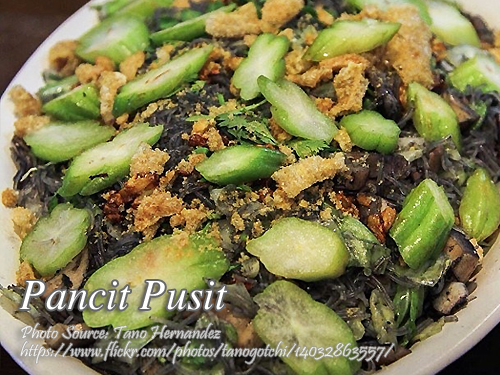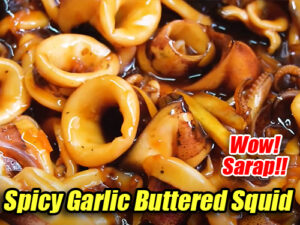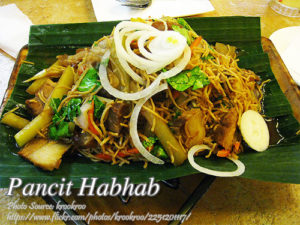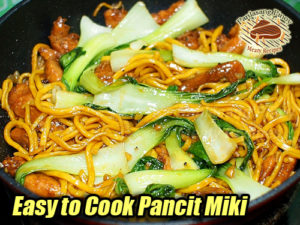Pancit pusit is a Caviteño noodle dish very similar to the well known pancit bihon or sotanghon that contains squid instead of pork or chicken meat. The original dish use bihon noodles but this recipe I have here use vermicelli or sotanghon noodles. This noodle dish also utilized the squid ink to make the noodle colored black and to distinguish it from the ordinary pancit bihon.
Pancit Pusit: Savoring Cavite’s Distinct Heritage
While growing up in Cavite, this kind of pancit is one specialty that always caught my attention at gatherings with the family. The dish is a tribute to the sea, much like the province itself. In fact, my Tito Mario, a fisherman by profession, would return home with fresh squid almost every week. My Tita Lourdes would have that squid’s ink in making her pancit bihon; she’d use it to give the dish its popular distinct black color, which always had me in awe as a child. The flavours, however captured both land and sea in every bite of it.
What makes Pancit Pusit Special?
If you are familiar with pancit bihon or sotanghon, you would realise that it follows most of those same procedures and materials. There’s just something about this dish that differentiates it from the rest – squid. While most noodle dishes rely on pork or chicken as their main ingredients, it revolves around the tender squid that swims in its very own ink, bringing beautiful balance to the rich, briny taste of the sea with the more familiar warmth of garlic, onions, and chilies. In my family, we make it with sotanghon or vermicelli noodles rather than the traditional bihon for a more silky texture, one that absorbs the dark, savory ink sauce very nicely.
My cousin Marites once tried to remake this one using a different kind of noodle but it just didn’t feel right. It was during this period that she consulted my Tita Lourdes, and it was there that we discovered how sotanghon makes the sauce stick better, so that by merely closing one’s mouth, every mouthful in the dish is really a flavor to behold. Tips like this could drive the idea that the history of a family is deeply rooted within the pancit dish.
The Secret to Cooking Perfect The Squid Pancit
Preparing the squid in this dish is all about timing. My Tito Mario always stressed that squid should never be overcooked. He said that squid is like life: you have to put the right amount of seasoning. And if it’s cooked too long, then it will be hard and chewy, which is why he ensures, when sautéed with garlic and onions and siling labuyo, that it stays on the heat for only about one to two minutes – that way it’s tender and doesn’t lose its flavor.
Elsewhere, the squid ink should be dealt with properly. One time when my Ate Liza was cleaning a squid, she accidentally pierced the ink sac-it was quite a mess inside the kitchen! In dealing with the ink sac, one really needs to be dainty in the way he deals with them, because this is what gives the pancit its color and that deep oceanic taste. It’s better to add that ink along with a bit of vinegar and patis to the sautéed squid mixture. The vinegar does not only enhance the tanginess but also balances the flavor of rich squid ink, making the dish harmoniously savory without overpowering.
A Balanced Dish with Deep Roots in Cavite’s History
Did you know that pancit pusit originated in the fishing communities from Cavite? Fact is, the province of Cavite, with waters bordering it, always basks under a vibrant fishing industry-and among the most abundant catches are squids. This was one of my Tito Mario’s favorites to come back from fishing every day. Squid, whatever form it took-whether meat or ink-this could not be wasted. They combined both in a dish, and so this very simple yet tasty dish came to be-a true reflection of the resourcefulness of the Caviteños and deep attachment to the sea.
To many of us who grew up by the coast, this is not just a satisfying meal. This is a celebration of local ingredients, long-standing traditions that go beyond mere sustenance, and bring families together for birthdays, fiestas, or simple gatherings. it is always a centerpiece on our table in as much as it represents both our love for food and our pride in our Caviteño roots.
How to Enjoy this Caviteño Classic
A final touch of kinchay or Chinese parsley gives a fresh, herbal note after the noodles are cooked and the squid is perfectly tender. For those who like a bit of spice, a few slices of siling labuyo can take the flavors up a notch. In our house, we also like it garnished with kamias fruit. The tartness it gives has a nice balance to that savory ink sauce. My Lola Pilar always says that “you will always squeeze the kamias before you eat, para mas malasa.”
No worries if it is your first time trying this out, and so long as you like it or not, adjusting the seasoning to your personal taste is perfectly fine. Pancit pusit is really flexible, and whether you like it a little bit spicy or tasting a little bit sour because of its vinegar content, you’d be surprised that you can make it any way you want.
A Dish to Remember
Every time I cook pancit pusit, the loving bond that foods bring my family to my mind. Each strand of pancit pushes my memories back into warm afternoons in Cavite, with the crackling sound of garlic in the pan and Tito Mario’s stories from the sea filling the air. This is more than just a dish-it’s part of our home, a reminder of our roots, and a good way to celebrate our rich heritage. Well, it’s already worth adding to your table, either you come from Cavite or a lover of pancit.
How to Cook Pancit Pusit
Ingredients
- 1/2 kilo squid
- 2 Tbsp. garlic minced
- 1 pc medium sized onion chopped
- 3 pcs siling labuyo or bird's eye chilies optional
- 3 pcs bay leaves
- 1 tsp. vinegar
- 1 tsp. patis fish sauce
- 1/2 tsp. pepper ground
- 500 grams vermicelli sotanghon noodles briefly soaked in water
- 1 bunch kinchay coarsely chopped
- 1 1/2 cup water
Instructions
How to cook Pansit Pusit:
- Gently clean the squid, carefully removing the ink sac without puncturing.
- Reserve the ink. Slice into rings, and the tentacles into bite-size pieces.
- Saute garlic, onion, siling labuyo and bay leaves. Add the squid and saute for 1 to 2 minutes.
- Add the vinegar, patis, pepper, water and reserved squid ink.
- Add the sotanghon. Cook at low heat and mix gently until the sotanghon is done.
- Adjust the seasoning if necessary. Transfer to a serving platter.
- Sprinkle with kinchay and siling labuyo if desired. Serve immediately.
- You can also garnish it with sliced kamias fruit.
Notes
Cooking Tips:
Treat the Squid Ink with Caution
While cleaning the squid, use utmost care as you remove the ink sac with no punctures or tears on it. Ink sac from the squid is what really gives pancit pusit that signature black color and rich, briny flavor. Use a very small knife with considerable care not to make a mess since the ink can stain.Never Overcook the Squid
Squid will turn hard and rubbery if overcooked. To be tender, sauté the squid only for one to two minutes once added to the garlic and onions. That's short enough already to allow squids to remain soft while absorbing all the savory flavors.Use Sotanghon Noodles for Better Absorption
Unlike the bihon, the sotanghon noodles are actually more fragile and really great at absorbing the richness of the sauce of the dish. Soaking the sotanghon in water before cooking helps its strands soften so that the squid ink sauce clings well to the noodles, making it a more flavorful dish.





